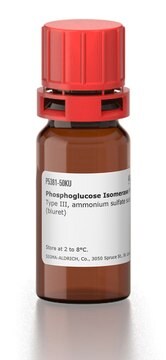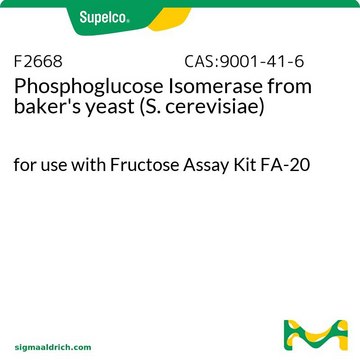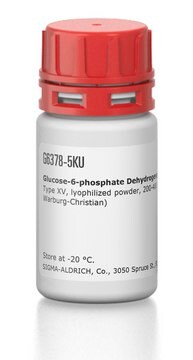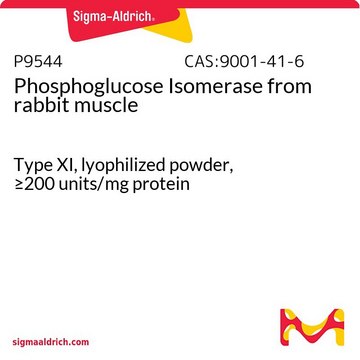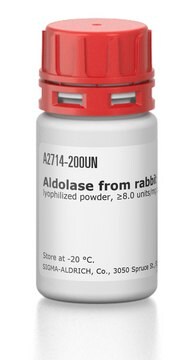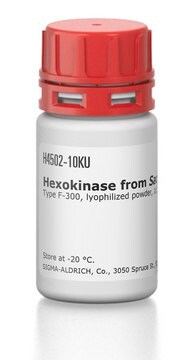P5538
Phosphoglucose Isomerase from Bacillus stearothermophilus
lyophilized powder, 300-1,000 units/mg protein
Synonyme(s) :
D-Glucose-6-phosphate ketol-isomerase, PGI, Phosphosaccharomutase
Se connecterpour consulter vos tarifs contractuels et ceux de votre entreprise/organisme
About This Item
Produits recommandés
Forme
lyophilized powder
Niveau de qualité
Activité spécifique
300-1,000 units/mg protein
Poids mol.
189 kDa
Composition
Protein, ≥60% biuret
Température de stockage
−20°C
Description générale
The enzyme is part of the glycolytic pathway. Also, it is important in the industrial production of fructose 1,6-diphosphate (FDP) from glucose. The molecular mass is found to be approximately 189 kDa and it consists of four subunits, each with a molecular mass of approximately 50 kDa. Optimum pH is found to be between 9-10 and the isoelectric point is 4.2.
Application
Phosphoglucose Isomerase (PGI) is an enzyme crucial for the interconversion of D-glucose 6-phosphate and D-fructose 6-phosphate. PGI is responsible for the second step of glycolysis and is involved in glucogenesis. It is highly conserved in bacteria and eukaryotes. It is used in sugar assays to convert fructose to glucose. This product is from Bacillus stearothermophilus.
The enzyme from Sigma has been used in the determination of fructose 6-phosphate in a mutant strain of Rhizobium meliloti.
Actions biochimiques/physiologiques
Phosphoglucose Isomerase fuctions as an isomerase, neuroleukin, autocrine motility factor, and a differentiation and maturation mediator.
Définition de l'unité
One unit will convert 1.0 μmole of D-fructose 6-phosphate to D-glucose 6-phosphate per min at pH 9.0 at 30 °C.
Forme physique
lyophilized powder containing Tris buffer
Mention d'avertissement
Danger
Mentions de danger
Conseils de prudence
Classification des risques
Resp. Sens. 1
Code de la classe de stockage
11 - Combustible Solids
Classe de danger pour l'eau (WGK)
WGK 3
Point d'éclair (°F)
Not applicable
Point d'éclair (°C)
Not applicable
Équipement de protection individuelle
Eyeshields, Gloves, type N95 (US)
Faites votre choix parmi les versions les plus récentes :
Déjà en possession de ce produit ?
Retrouvez la documentation relative aux produits que vous avez récemment achetés dans la Bibliothèque de documents.
A Arias et al.
Journal of bacteriology, 137(1), 409-414 (1979-01-01)
A mutant strain of complex phenotype was selected in Rhizobium meliloti after nitrosoguanidine mutagenesis. It failed to grow on mannitol, sorbitol, fructose, mannose, ribose, arabitol, or xylose, but grew on glucose, maltose, gluconate, L-arabinose, and many other carbohydrates. Assay showed
The Kinetics and Mechanism of a Reaction Catalyzed by Bacillus stearothermophilus Phosphoglucose Isomerase.
Widjaja A, et al.
Journal of Fermentation and Bioengineering, 86(3), 324-331 (1998)
Kosei Nakajima et al.
Oncology reports, 28(6), 1953-1958 (2012-10-03)
Autocrine motility factor (AMF) plays an important role in the development of metastasis by regulating tumor cell motility. The expression of AMF is associated with metastasis in malignant musculoskeletal tumors including osteosarcoma. Recent studies indicated that hyperthermia contributes to the
Veera Kainulainen et al.
Journal of bacteriology, 194(10), 2509-2519 (2012-03-06)
Glutamine synthetase (GS) and glucose-6-phosphate isomerase (GPI) were identified as novel adhesive moonlighting proteins of Lactobacillus crispatus ST1. Both proteins were bound onto the bacterial surface at acidic pHs, whereas a suspension of the cells to pH 8 caused their
Simone Frédérique Brenière et al.
PLoS neglected tropical diseases, 6(5), e1650-e1650 (2012-06-12)
The current persistence of Triatoma infestans (one of the main vectors of Chagas disease) in some domestic areas could be related to re-colonization by wild populations which are increasingly reported. However, the infection rate and the genetic characterization of the
Notre équipe de scientifiques dispose d'une expérience dans tous les secteurs de la recherche, notamment en sciences de la vie, science des matériaux, synthèse chimique, chromatographie, analyse et dans de nombreux autres domaines..
Contacter notre Service technique

